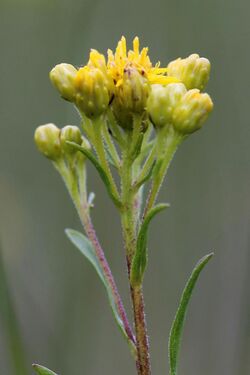Biology:Solidago Houghtonii
| Solidago Houghtonii | |
|---|---|

| |
| Scientific classification | |
| Kingdom: | Plantae |
| Clade: | Tracheophytes |
| Clade: | Angiosperms |
| Clade: | Eudicots |
| Clade: | Asterids |
| Order: | Asterales |
| Family: | Asteraceae |
| Genus: | Solidago |
| Species: | S. houghtonii
|
| Binomial name | |
| Solidago houghtonii | |
Solidago houghtonii also known as Houghton's goldenrod[1] is a Michigan wild flower that grows along the shoreline of the Great Lakes.
Region
Solidago houghtonii is native to Michigan growing in the areas of Chippewa, the western side of Mackinac, northern Emmet, Cheboygan and northern Presque Isle Counties, also growing in the Bruce Peninsula of Ontario, Canada. Growing on the Northern shores of Lake Michigan and Lake Huron on the sandy beaches and shallow areas between low sand ridges where it is very moist, this habitat is commonly referred to as interdunal wetland. During the times of high water lines, the plant can be submerged in water and when the water levels recede only some of the plants will survive the change in environment, while new seedlings will be created on the sand.
Plant identification
Characteristics
The Solidago houghtonii grows to be 8-20[2] inches tall. It is shade intolerant and has flat top flower heads. The flower has elongated rays and can range from having 10-200[3] flowers on each plant. The stem leaves tend to be sparse, narrow and long. The stem is woody, red in color and can reach between 30 and 60 cm.[3] The roots of the flower are fibrous.
Habitat
This plant lives and thrives in damp, sandy shores, low dunes, between rocks and cobbles on the beach, fens, and swales.
Season
Solidago houghtonii blooms in late summer, August and September.
Protection
Solidago houghtonii is protected by the Ontario Endangered Species Act, and in Michigan is protected by the State and Federal Government because it is endangered.
Hay fever
People have believed for the longest time that the Solidago houghtonii was the cause for hay fever. This is not true, the Ragweed Flower is responsible for causing this fever and people commonly mistake the causing flower because these flowers bloom at the same time.[2]
References
- ↑ "DNR - Houghton's Goldenrod (Solidago houghtonii)" (in en). http://www.michigan.gov/dnr/0,4570,7-153-10370_12146_12213-61388--,00.html.
- ↑ 2.0 2.1 "Houghton’s goldenrod" (in en-US). Michigan Sea Grant. 2013-03-20. http://www.miseagrant.umich.edu/explore/native-and-invasive-species/species/plants/houghtons-goldenrod/.
- ↑ 3.0 3.1 "Species at Risk – Houghton's Goldenrod" (in en). Ontario's Ministry of Natural Resources and Forestry. http://mnrsar.cat.webfeat.com/pages/MNR_SAR_HGHTNS_GLDNRD_EN.aspx.

